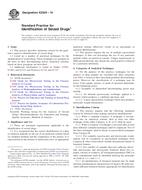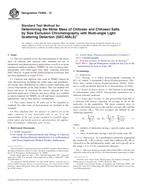Potrebujeme váš súhlas na využitie jednotlivých dát, aby sa vám okrem iného mohli ukazovať informácie týkajúce sa vašich záujmov. Súhlas udelíte kliknutím na tlačidlo „OK“.
ASTM F2900-11
Standard Guide for Characterization of Hydrogels used in Regenerative Medicine (Withdrawn 2020)
Automaticky preložený názov:
Štandardné Príručka pre charakterizáciu hydrogélov použité v regeneratívnej medicíne
NORMA vydaná dňa 15.3.2011
Informácie o norme:
Označenie normy: ASTM F2900-11
Poznámka: NEPLATNÁ
Dátum vydania normy: 15.3.2011
Kód tovaru: NS-54700
Počet strán: 10
Približná hmotnosť: 30 g (0.07 libier)
Krajina: Americká technická norma
Kategória: Technické normy ASTM
Kategórie - podobné normy:
Anotácia textu normy ASTM F2900-11 :
Keywords:
gel, hydrogel, regenerative medicine, tissue engineered medical products (TEMPs), ICS Number Code 11.120.10 (Medicaments)
Doplňujúce informácie
| Significance and Use | ||||||||||||||||||||||||||||||||
|
This guide describes methods for determining the key attributes of hydrogels used in regenerative medicine (that is, their biological properties, kinetics of formation, degradation and agent release, physical and chemical stability and mass transport capabilities). See Table 1. |
||||||||||||||||||||||||||||||||
| 1. Scope | ||||||||||||||||||||||||||||||||
|
1.1 Hydrogels are water-swollen polymeric networks that retain water within the spaces between the macromolecules; and maintain the structural integrity of a solid due to the presence of cross-links (1-3). They are mainly used in regenerative medicine as matrix substitutes, delivery vehicles for drugs and/or biologics, and environments for cell culture. In these applications, hydrogel efficacy may depend on the ability to: support the permeation of dissolved gases, nutrients and bioactive materials; sustain cell growth and migration; degrade; release drugs and/or biologics at an appropriate rate; and maintain their shape. 1.2 Hydrogels used in regenerative medicine can be composed of naturally derived polymers (for example, alginate, chitosan, collagen (4, 5)), synthetically derived polymers (for example, polyethylene glycol (PEG), polyvinyl alcohol (PVA) (4, 5)) or a combination of both (for example, PVA with chitosan or gelatin (6)). In clinical use, they can be injected or implanted into the body with or without the addition of drugs and/or biologics (7). 1.3 This guide provides an overview of test methods suitable for characterizing hydrogels used in regenerative medicine. Specifically, this guide describes methods to assess hydrogel biological properties, kinetics of formation, degradation and agent release, physical and chemical stability and mass transport capabilities are discussed. 1.4 The test methods described use hydrated samples with one exception: determining the water content of hydrogels requires samples to be dried. It is generally recommended that hydrogels that have been dried for this purpose are not rehydrated for further testing. This recommendation is due to the high probability that, for most hydrogel systems, the drying-rehydration process can be detrimental with possible alterations in structure. 1.5 This guide does not consider evaluation of the microstructure of hydrogels (for example, matrix morphology, macromolecule network structure and chain conformation). 1.6 The values stated in SI units are to be regarded as standard. No other units of measurement are included in this standard. 1.7 This standard does not purport to address all of the safety concerns, if any, associated with its use. It is the responsibility of the user of this standard to establish appropriate safety and health practices and determine the applicability of regulatory limitations prior to use. |
||||||||||||||||||||||||||||||||
| 2. Referenced Documents | ||||||||||||||||||||||||||||||||
|
Podobné normy:
Historická
15.12.2010
Historická
15.5.2009
Historická
1.8.2010
Historická
1.6.2011
Historická
1.8.2013
Historická
1.2.2008



 ASTM E2329-10
ASTM E2329-10 ASTM E2476-09
ASTM E2476-09 ASTM E2656-10
ASTM E2656-10 ASTM E2764-11
ASTM E2764-11 ASTM F2602-13
ASTM F2602-13 ASTM F2605-08e1
ASTM F2605-08e1
 Cookies
Cookies
